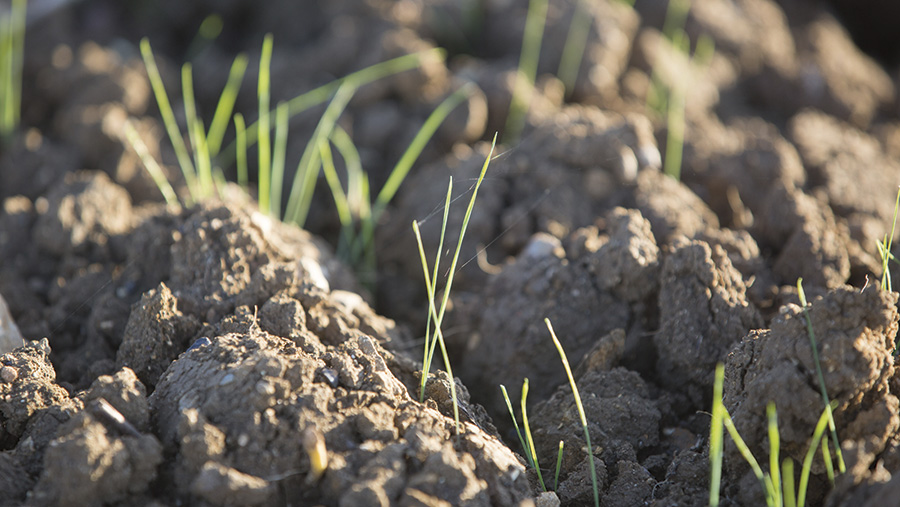Crop Watch: Weed war rages on as herbicide strategies are weighed up
 © Tim Scrivener
© Tim Scrivener Waiting for blackgrass to chit in dry soils is proving painful in Essex this week, as Marcus Mann considers robust herbicide options this autumn.
Patrick Stephenson ponders when to attack volunteer oilseed rape and beans in cereals now or in the spring, noting that bouts of blackgrass are forcing plans to be re-evaluated in certain cases.
In the West, Giles Simpson says good ground conditions and a largely unhindered maize harvest mean cover crops are going into ground that would normally have been left bare over winter.
See also: Crop Watch: Growers who delayed drilling will see benefits
Crops in the South East will need close monitoring warns Kevin Knight, with rising instances of aphids and blackgrass prompting insecticide and herbicide sprays to keep these threats in check.
East: Marcus Mann
 Frontier (Essex)
Frontier (Essex)
Continued dry conditions have allowed a wide drilling window, but the question is for how much longer can we hold our nerve and delay drilling to allow blackgrass emergence?
By this stage last year, with damper conditions and lower dormancy, we had seen a good flush through before drilling. At present, we are still waiting for blackgrass to break dormancy.
In Essex the main feature continues to be lack of moisture, with early drillings particularly on heavy land is emerging slowly and very patchy. This will bring slug issues if the crops don’t get away quickly.
Following 15mm of rainfall in the last week, this has finally encouraged small populations of blackgrass to germinate which will reward those who had patience.
Once in the ground the plan will be to apply a robust residual stack, however there are concerns how effective these will be with soils being so dry.
Apart from Avadex, which needs to be on as soon as the field is drilled, there is an argument on dry soils for a very slight delay this year with the flufenacet base, as being later with cooler soil temperatures the crops will not rush through the ground.
But be very careful if considering this as it is better to get it on early, than miss the opportunity altogether.
Crops that were drilled into moist seed-beds that have had a pre-emergence spray will receive a flufenacet top-up early on.
Remember, if drilling has been delayed make sure to increase the seed rate. From late-October onwards you should be looking for 350-425 seeds/sq m.
Keep a watch on aphids as significant numbers of barley yellow dwarf virus (BYDV) vectors have been observed on emerging green bridge stubbles and in national suction traps.
Oilseed rape establishment has been very poor this year, with estimated remaining areas in Essex looking as though it will be less than 20% left of what was originally planted.
With spends on this crop being limited until an established crop was guaranteed, the removal has brought about some positive factors in that it will allow further flushes of grass weeds through into the spring to be removed.
Crops that remain have had growth stimulants containing phosphites applied to encourage root growth to improve winter hardiness.
North: Patrick Stephenson

AICC (Yorkshire)
With variable weather across the country I am wary of commenting too much on the state of crops. However, for my part of the world it has been a very kind period and crops are emerging well.
Slug activity has been minimal and applications of pellets have been largely confined to defined areas rather than whole fields.
Despite dire warnings and concerns over aphids it has been difficult to find any in crops. I will admit that 50-year-old eyes help here but even younger colleagues are confirming the lack of aphids.
Despite this I will be keeping aphicide sprays for the most forward crops, drilled in September.
Those drilled in late October will probably not require a spray, leaving those in early to mid-October in the Twilight Zone which we will monitor.
Volunteer beans and oilseed rape are a challenge in cereal crops, do I go now or wait until spring? Applying sulphonylureas for autumn blackgrass will tidy them up, but for those with no blackgrass it is an exercise in patience.
There are already some blackgrass casualties and plans are being re-drawn for some fields. Drilling is continuing after maize, potatoes and sugar beet, and the soil is still in surprisingly good condition.
After harvest these fields often resemble a battle field, but this year the Environment Agency can breathe a little easier as hopefully all will be quickly drilled and established.
Winter barley is establishing well and nearly all have had a robust pre-emergence program. Those that have not will receive a chlortoluron, diflufenican and pendimethalin combination post-emergence.
Early drilled beans have received a pre-emergence based around pendimethalin and, despite the warm soil temperatures, propyzamide.
Oilseed rape crops still have no phoma lesions so disease control programs will be a one-hit approach. This will be combined with a propyzamide treatment in approximately 10 days.
Broad-leaved weeds that have escaped the early herbicides are more of a challenge, and we can’t even look at charlock and runch control until the frosts arrive.
West: Giles Simpson
 Pearce Seeds (Somerset)
Pearce Seeds (Somerset)
How pleasing and unusual it is to say that weather and ground conditions couldn’t have been better for drilling, spraying and maize harvesting over the past few weeks.
We are pretty well all drilled up in down here and it has mostly been done in near perfect seed-bed conditions.
The early drilled wheat looks all good, slugs have been an issue in some cases, but in general have not been a major problem.
Herbicides seem to have done a good job, mainly due to good seed-beds and a small amount of rain at times. Crops not dressed with Deter (clothianidin), which thankfully are very few, have had an aphicide applied already and there may need to be another unless we get some cold weather.
Most of the later sown wheat behind maize crops have had Deter-dressed seed and then a pre-emergence herbicide applied – we are not going to get caught like last year again.
If conditions allow, these crops will have a follow up herbicide and aphicide applied later.
The early maize harvest and good ground conditions have allowed for cover crops to be sown into stubbles that would have remained bare all winter.
This will surely help in reducing erosion and the bad publicity that surrounds maize stubbles. It is certainly noticeable that farmers are much more aware of the environmental issues around maize growing.
The oilseed rape crops are variable, with some very forward, to crops that have been pestered by slugs, but generally they look good. Herbicides seem to be working well and phoma hasn’t yet been a problem, but could be going forward.
South: Kevin Knight
 Zantra (Kent)
Zantra (Kent)
Winter drilling is largely completed in my area, and cereals are coming on well where rainfall has been sufficient.
That said, there has been a very slow emergence of grassweeds, with blackgrass only starting to show over the past couple of weeks.
Early drilled, dry fields will need careful monitoring and graminicide top ups of prosulfocarb (Defy), flufenacet and diflufenican (as in Liberator, Firebird) applied where needed.
Bird cherry-oat aphids are about, so single-purpose treated cereals got an insecticide treatment this week, as will any Deter (clothianidin) treated crops that have been out of the ground more than a month.
I suspect more will pay attention to this application than they did last autumn.
If going through winter oats with an insecticide in November, I tend to include a couple of litres of foliar manganese as there is evidence that this can reduce winter kill in a harsh season.
The dramatic shift in some varieties’ yellow rust disease ratings announced last week needs to be noted.
I will be rethinking strategies for my Zulu (9 down to 5) and Diego (7 down to 5), and monitoring any further info on the confirmed Kranich race and likely new Invicta race from the AHDB this winter.
There are still parts of the South East that have had nowhere near enough moisture since the oilseed rape was drilled, leaving many crops a long way behind where I’d like them to be going into winter.
Plant populations are generally good, with only a small area being given up on and drilled with winter beans. Where there’s potential a chance has been taken, with flea beetle and slugs being shown no quarter.
If the pigeons get the better of backward rape, spring beans will follow.
Soil temperatures are still a bit high for propyzamide (Kerb) applications, and in many areas soil moisture is too low.
Grassweeds are slow to germinate – in some cases clethodim couldn’t be justified in the application window, so getting the Kerb application right is going to be crucial.
In the interim I have used carbetamide (Crawler) to check any small blackgrass that’s emerging.

